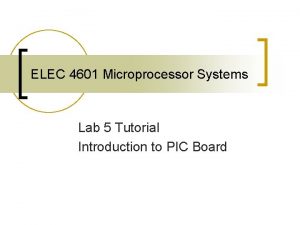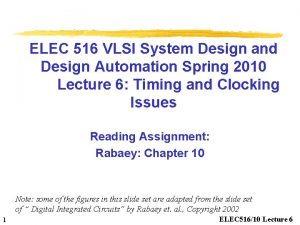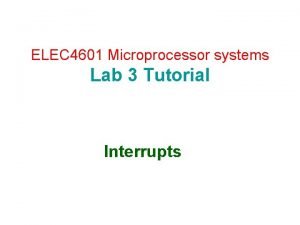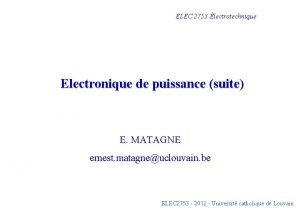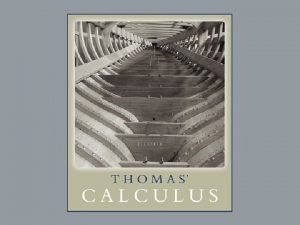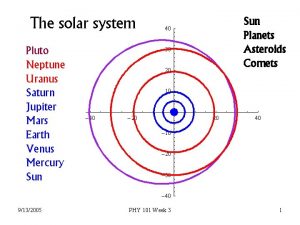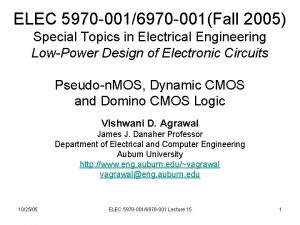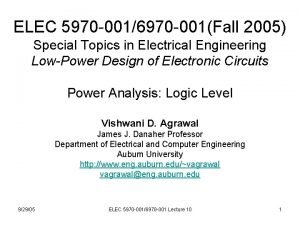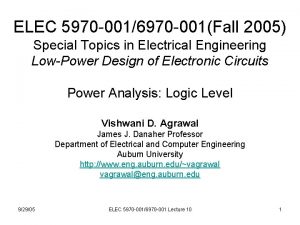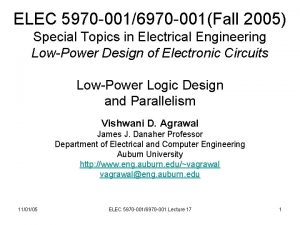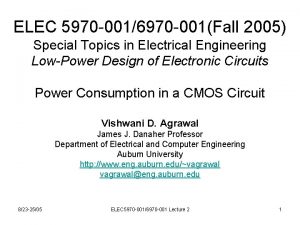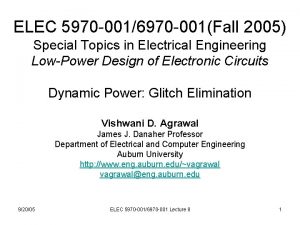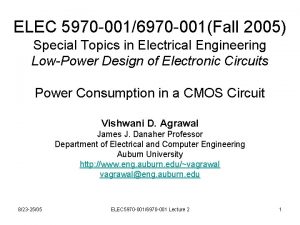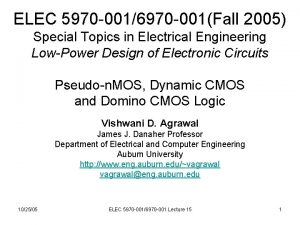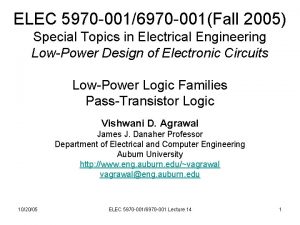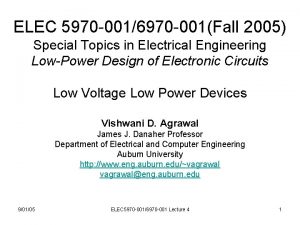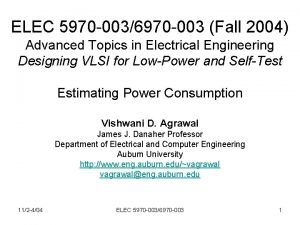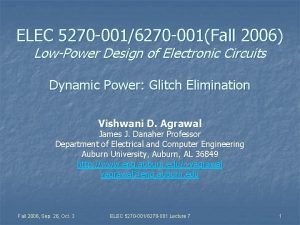ELEC 5970 0016970 001Fall 2005 Special Topics in
















- Slides: 16

ELEC 5970 -001/6970 -001(Fall 2005) Special Topics in Electrical Engineering Low-Power Design of Electronic Circuits Dynamic Power Vishwani D. Agrawal James J. Danaher Professor Department of Electrical and Computer Engineering Auburn University http: //www. eng. auburn. edu/~vagrawal@eng. auburn. edu 9/13/05 ELEC 5970 -001/6970 -001 Lecture 6 1

CMOS Dynamic Power = Σ 0. 5 αi fclk CLi VDD 2 All gates i ≈ 0. 5 α fclk CL VDD 2 ≈ α 01 fclk CL VDD 2 where 9/13/05 α α 01 fclk CL VDD average gate activity factor = 0. 5α, average 0→ 1 trans. clock frequency total load capacitance supply voltage ELEC 5970 -001/6970 -001 Lecture 6 2

Example: 0. 25μm CMOS Chip • • • f = 500 MHz Average capacitance = 15 f. F/gate VDD = 2. 5 V 106 gates Power = α 01 f CL VDD 2 = α 01× 500× 106×(15× 10 -15× 106) × 2. 52 = 46. 9 W, for α 01 = 1. 0 9/13/05 ELEC 5970 -001/6970 -001 Lecture 6 3

Signal Activity, α T=1/f Clock α 01= 1. 0 α 01= 0. 5 Comb. signals α 01= 0. 5 9/13/05 ELEC 5970 -001/6970 -001 Lecture 6 4

Reducing Dynamic Power • Dynamic power reduction is – Quadratic with reduction of supply voltage – Linear with reduction of capacitance 9/13/05 ELEC 5970 -001/6970 -001 Lecture 6 5

2. 5 0 2. 0 -4 1. 5 -8 Gain Vout (V) 0. 25μm CMOS Inverter, VDD=2. 5 V 1. 0 -12 0. 5 -16 0 -20 0 0 0. 5 1. 0 1. 5 2. 0 2. 5 Vin (V) 9/13/05 ELEC 5970 -001/6970 -001 Lecture 6 0. 5 1. 0 1. 5 2. 0 2. 5 Vin (V) 6

0. 25μm CMOS Inverter, VDD< 2. 5 V 2. 5 0. 2 Vout (V) 2. 0 1. 5 1. 0 0. 15 0. 1 0. 5 0. 05 0 0. 5 1. 0 1. 5 2. 0 Vin (V) 9/13/05 2. 5 0 Gain = -1 ELEC 5970 -001/6970 -001 Lecture 6 0. 05 0. 15 0. 2 Vin (V) 7

Lower Bound on VDD • For properation of gate, maximum gain (for Vin = VDD/2) should be greater than 1. • Gainmax = -(1/n)[exp(VDD /2ΦT) – 1] = -1 • n = 1. 5 • ΦT = k. T/q = 26 m. V • VDD = 48 V • VDDmin > 2 to 4 times k. T/q or ~100 m. V at room temperature (27 o. C) • Ref. : J. M. Rabaey, A. Chandrakasan and B. Nikolić, Digital Integrated Circuits, Upper Saddle River, New Jersey: Pearson Education, 2003. 9/13/05 ELEC 5970 -001/6970 -001 Lecture 6 8

Impact of VDD on Performance Inverter delay = CLVDD K ─────── (VDD – Vt )α Delay (ns) 40 30 20 Power 10 Delay 0 0. 6 V VDD=Vt 9/13/05 1. 8 V ELEC 5970 -001/6970 -001 Lecture 6 3. 0 V VDD 9

Optimum Power × Delay, PD = VDD 3 constant × ─────── (VDD – Vt)α For minimum power-delay product, d(PD)/d. VDD = 0 VDD = 3 Vt ─── 3–α For long channel devices, α = 2, VDD = 3 Vt For very short channel devices, α = 1, VDD = 1. 5 Vt 9/13/05 ELEC 5970 -001/6970 -001 Lecture 6 10

Transistor Sizing for Performance • Problem: If we increase W/L to make the charging or discharging of load capacitance, then the increased W increases the load for the driving gate Cin 9/13/05 CL ELEC 5970 -001/6970 -001 Lecture 6 11

Fixed-Taper Buffer Delay = t 0 Vin 1 Cin α α 2 αi-1 Ci = αi-1 Cin CL = αn. Cin αn-1 Vout CL Ref. : J. Segura and C. F. Hawkins, CMOS Electronics, How It Works, How It Fails, Piscataway, New Jersey: IEEE Press, 2004. 9/13/05 ELEC 5970 -001/6970 -001 Lecture 6 12

Buffer (Cont. ) αn n = CL/Cin = ln (CL/Cin) ────── ln α ith stage delay, ti = αt 0, i = 1, . . . n, because each stage drives a stage α times bigger than itself. 9/13/05 ELEC 5970 -001/6970 -001 Lecture 6 13

Buffer (Cont. ) Total delay = n Σ ti = i=1 nαt 0 = ln(CL/Cin) αt 0/ln(α) 9/13/05 ELEC 5970 -001/6970 -001 Lecture 6 14

Buffer (Cont. ) Differentiating total delay with respect to α and equating to 0, we get αopt = e ≈ 2. 7 The optimum number of stages is nopt = ln(CL/Cin) 9/13/05 ELEC 5970 -001/6970 -001 Lecture 6 15

Further Reading B. S. Cherkauer and E. G. Friedman, “A Unified Design Methodology for CMOS Tapered Buffers, ” IEEE Trans. VLSI Systems, vol. 3, no. 1, pp. 99 -111, March 1995. 9/13/05 ELEC 5970 -001/6970 -001 Lecture 6 16
 Picture recognition
Picture recognition Superposition electric circuits
Superposition electric circuits Elec 4601
Elec 4601 Dec alpha 21264
Dec alpha 21264 Elec4601
Elec4601 Elec
Elec Elec service plus
Elec service plus Elec
Elec Software engineering course syllabus
Software engineering course syllabus Special investigative topics 3232 answers
Special investigative topics 3232 answers Dena schlosser
Dena schlosser Copyright 2005
Copyright 2005 Pluto planta
Pluto planta Peraturan pemerintah nomor 58 tahun 2005
Peraturan pemerintah nomor 58 tahun 2005 Ada 2005
Ada 2005 Gudi padwa 2003
Gudi padwa 2003 Rti act 2005 introduction
Rti act 2005 introduction


